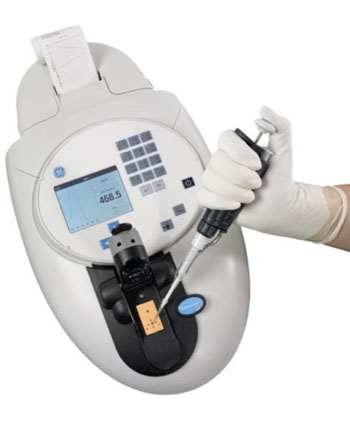Novel Molecular Blood Group Typing Technique Developed
By LabMedica International staff writers
Posted on 24 Apr 2014
A new system for molecular blood group typing has been designed that offers blood banks the possibility of extensive screening of blood donors at a relatively low cost.Posted on 24 Apr 2014
Although blood transfusion is generally safe, occasionally alloimmunization, which is when an antibody is formed in response to an antigen that is not present on a person's own red blood cells (RBCs), remains a dreaded complication, particularly in patients with sickle cell diseases.

Image: The NanoVue spectrophotometer (Photo courtesy of GE Healthcare).
Scientists at the Etablissement Français du Sang Pyrénées Méditerranée (La Plaine, Saint-Denis, France) developed a new flexible DNA microarray platform for molecular blood group typing. This includes two robotic workstations that allow processing from blood sample to the genotype. A pilot study shows promising results for responding to blood donor laboratories' requirements for simple, low-cost screening.
A total of 1,132 anticoagulated blood samples were from random donors, mostly Caucasian, who were extensively phenotyped using standard serologic hemagglutination techniques. One hundred seventy-two samples were used to determine scoring criteria for predicting phenotype. The remaining 960 samples were used for validation of the 96-well DNA microarray system.
Genomic DNA extraction from whole blood samples was performed using a MagNA Pure 96 system (Roche Diagnostics, Rotkreuz, Switzerland) and Roche’s Viral NA Small Volume Kit in a 96-well microarray plate. After extraction, DNA was eluted and quantified using a NanoVue spectrophotometer (GE Healthcare; Little Chalfont, UK).
A total of 938 samples were considered as valid and assigned genotypes based on the scoring criteria determined for the eight single-nucleotide polymorphism (SNPs). Phenotypes predicted from genotypes were compared with those obtained by serologic typing. The concordance rate between the DNA-based and standard hemagglutination assays was high for all four blood group systems. Only three predicted phenotypes that involved the KEL, JK, and MNS systems were discordant. This version allows simultaneous multiplex assay of up to 96 samples in a single reaction run, but the system allows other DNA microarray formats with a lower number of wells to be easily adapted and processed on this platform.
Jean-Charles Brès, PhD, The lead investigator, said, “The availability of high throughput DNA-based blood-group genotyping would be a great boon for transfusion medicine. In addition to providing more fully antigen-matched RBCs and allowing better identification of rare donor blood types, this technology will reduce adverse reactions and decrease the relative cost of analysis.” The cost would be less than USD 2.60 per SNP. The study was published in the May 2014 issue of the Journal of Molecular Diagnostics.
Related Links:
Etablissement Français du Sang Pyrénées Méditerranée
Roche Diagnostics
GE Healthcare













